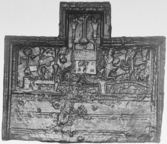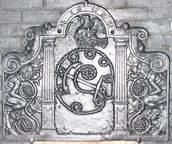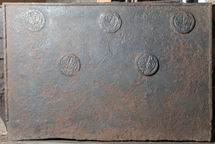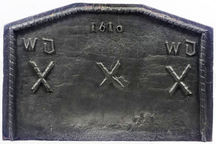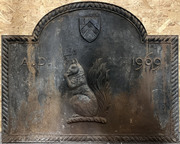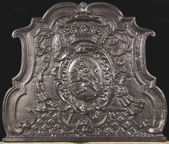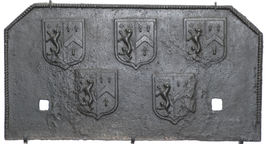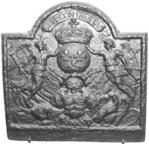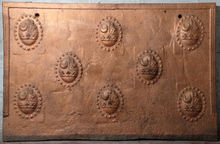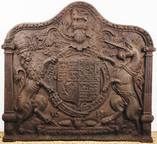-
422
Description: Rectangular with a square projection middle top; castellated top edging; top centre, stylised Calvary; upper section: pictorial scene, centre, house with tiled roof, windows, and chimney at each end, paths leading from house; left, possible forge building with four chimneys and three water wheels, and adjacent furnace stack?; above, shed with lean-to, barrow, and wheel structure, all between trees; right, figure of a man running towards the house, unidentified objects between trees; lower section: plain panel with central triple-grooved horizontal line.
Notes: A striking and unusual fireback with a scene suggesting a connection with iron-making. Formerly part of the J. H. Every collection.
Copies of this fireback are known.
- Decoration tags:
- rectangular with square arch (shape)
- castellated (edging)
- whole carved pattern
- pictorial
- humans
- plants
- objects
Manufactured: in the late-16th to early-17th century possibly in the Eifel area of Germany.
Current location: Anne of Cleves House, Southover High Street, Lewes, East Sussex, England.
Museum number: 1944.24.045 (part of the Sussex Archaeological Society museum group)
- Attached to series:
- Miscellaneous pattern firebacks
-
585
Description: Central arched rectangular shape formed of fluted Ionic pilasters supporting a rounded arch, with fillet edging, bearing the date between two flower heads; beneath is a fouled anchor within a circlet of rope gathered into eight loops; a phoenix, its wings displayed and inverted, rises from the flames above the rope; mirrored outside each pilaster, a crouching, naked faun, facing inwards, disgorges a vine with bunches of grapes; above each faun a volute forms the top corner of the plate.
Notes: The decorative elements of this fireback have yet to be fully interpreted; the vines disgorged from the mouths of the fauns are related to the 'green man' tradition associated with woodland spirits and symbolising resurrection, the latter echoed by the phoenix, though in the form in which they appear on this fireback they may be a purely decorative device. By contrast, the cabled anchor is the badge of the Lord High Admiral who, in 1608, was Charles Howard, 1st Earl of Nottingham (previously Lord Howard of Effingham). A pastiche of this fireback, dated 1633, is also known (no. 1064).
Copies of this fireback are known.
Inscription: 1608
- Decoration tags:
- rectangular with canted top corners and round arch (shape)
- fillet (edging)
- whole carved pattern
- pictorial
- mythological
- text
- humans
- plants
- objects
Manufactured: in 1608 in the Weald area of England.
Current location: Petworth House, Petworth, West Sussex, England.
Museum number: NT/L/PET/M/117.1 (part of the National Trust museum group)
Citation: Lloyd, N., 1925, 'Domestic Ironwork I', Architectural Review, 58, pp. 58-67.
- Attached to series:
- Miscellaneous pattern firebacks
- Phoenix firebacks
-
662
Description: Rectangular; fillet edging (top and sides, except c.100mm at bottom of each side); arrangement of a circular butter print with fleur de lys design, repeated four times: one in each top corner, and two evenly spaced across the middle of the plate; a single circular butter print stamp with a heart-shaped design in the middle top position.
Notes: The fleur de lys stamp can also be seen on a fireback at Nymans, Handcross (no. 96); one of the Pounsley series of firebacks.
- Decoration tags:
- rectangular (shape)
- fillet (edging)
- simple stamps
- objects
Manufactured: in the mid- to late-16th century possibly at Pounsley Furnace, Framfield in the Weald area of England.
Current location: Hole Park, Rolvenden, Kent, England.
- Attached to series:
- Pounsley series
- Food mould stamp firebacks
-
892
Description: Canted rectangular shape; plain edging with inset ?leather strap twisted round dowel (top and sides); top centre, date probably in stamped numerals; twisted leather strap saltire repeated three times across middle of plate; pair of stamped initials, formed of a Roman 'W' and a Gothic 'd', above each outer saltire.
Notes: Sotheby's sale London 27 November 2006, lot 324; formerly at Brunger, Kent (near Tenterden).
Inscription: 1610 / WD WD
- Decoration tags:
- rectangular with canted top corners (shape)
- none (edging)
- simple stamps
- individual letters
- individual numbers
- apotropaic
- text
- objects
Manufactured: in 1610 in England.
Current location: not known.
- Attached to series:
- Date & initials firebacks
- Miscellaneous stamp firebacks
-
1257
Description: Arched rectangular shape, edged with simulated twisted rope between two fillets; in the arch, a shield: argent on a chevron gules three roses of the field, a canton gules for difference; beneath the shield a crest: on a wreath a squirrel sejant gules cracking a nut gules, charged on the shoulder with a cross crosslet gold for difference; inscription split either side of the head of the squirrel.
Notes: A finely modelled and cast modern fireback with the arms and crest of a direct descendant of John Davies Gilbert (1811-54) who had played a major role in the development of the town of Eastbourne and also developed Trelissick Garden in Feock, Cornwall.
Inscription: A.D. 1969
Arms: Gilbert, of Eastbourne, Sussex, and Trelissick, Cornwall
- Decoration tags:
- rectangular with round arch (shape)
- fillet (edging)
- whole carved pattern
- heraldic
- armorial
- text
- animals
Manufactured: in 1969 in England.
Current location: noit known.
- Attached to series:
- Personal armorial firebacks
-
988
Description: Complex quasi-arched rectangular shape with astragal and fillet edging; within a parallel border and a rococo cartouche an oval shield (argent, a lion rampant sable, crowned, armed and langued gules), surmounted by a ducal coronet, and a bishop's mitre and crozier; above, a bishop's hat with trailing tassels; below, a compartment semie with diamond shapes.
Notes: Henri-Louis-René de Nos (1717-93) was abbot of Saint-Sauveur de Redon in 1747 and later, successively, Bishop of Rennes and of Verdun.
Arms: Henri-Louis-René de Nos
- Decoration tags:
- rectangular with canted top corners and round arch (shape)
- astragal & fillet (edging)
- whole carved pattern
- armorial
Manufactured: in the mid- to late-18th century in France.
Current location: not known.
Citation: Palasi, P., 2014, Plaques de Cheminées Héraldiques (Paris, Éditions Gourcuff-Gradenigo).
- Attached to series:
- Foreign armorial firebacks
-
741
Description: Rectangular, with canted top corners; twisted rope edging (top and sides only); five shields of Ayloffe impaling Sulyard in two rows, 3-2; Ayloffe: sable, a lion rampant Or, collared gules, between three crosses formy of the second; Sulyard: argent, a chevron gules between three pheons inverted sable. Two cut notches probably for firedogs.
Notes: William Ayloffe (c1535-1584) of Bretons, Hornchurch, Essex, Justice of the Court of Queen’s Bench, married (c1560) Jane, dau. of Sir Eustace Sulyard, of Runwell, Essex. A large number of variants use the same shields. The excrescences affecting the left and right sides respectively of the lower shields are the result of inexpert ladling of the iron during casting. Part of the bequest to the Victoria and Albert Museum by Lieut. Colonel G. B. Croft-Lyons in 1926.
Arms: Ayloffe impaling Sulyard (William Ayloffe of Bretons, Hornchurch)
- Decoration tags:
- rectangular with canted top corners (shape)
- rope (edging)
- carved stamps
- armorial
Manufactured: in the early-17th century in the Weald area of England.
Current location: Victoria & Albert Museum, Cromwell Road, Kensington & Chelsea, Greater London, England.
Museum number: M.621-1926 (part of the Victoria & Albert Museum museum group)
- Attached to series:
- Ayloffe series
- Personal armorial firebacks
- Andiron slot firebacks
-
761
Description: Arched rectangular; astragal edging with simiulated ribbon pattern; inscription on a banner in arch; crowned roundel bearing the arms of France between two angel supporters carrying trumpets; below, a triumph of arms; on the bottom, a plain extension panel.
Notes: The motto, translated, reads 'Alone against all'; other firebacks bear the motto, 'Victorieux contre tous' (Victorious against all).
Inscription: SEVL CONTRE TOVS
Arms: France modern
- Decoration tags:
- rectangular with round arch (shape)
- astragal (edging)
- whole carved pattern
- extension panels
- armorial
- text
- humans
- objects
Manufactured: in the late-17th century in France.
Current location: Victoria & Albert Museum, Cromwell Road, Kensington & Chelsea, Greater London, England.
Museum number: M.3-1918 (part of the Victoria & Albert Museum museum group)
Citation: Carpentier, H., 1912, Plaques de Cheminées (Paris, published by the author).
- Attached to series:
- Foreign armorial firebacks
-
1043
Description: Rectangular; triple-fillet moulded edging formed of lengths of carved wood (top and upper seven-eights of sides only); stamp formed of an elliptical shield enclosed within an elliptical border of 23 beads, all mounted on a rectangular block, repeated eight times symmetrically 3-2-3.
Notes: This is a rare example of elliptical arms on a fireback; in each instance the stamp has been over-pressed so that the block on which it was carved has appeared in relief.
Arms: not known
- Decoration tags:
- rectangular (shape)
- triple-fillet moulding (edging)
- simple stamps
- carved stamps
- heraldic
- armorial
Manufactured: in the 17th century in England.
Current location: in private hands, West Hoathly, West Sussex, England.
- Attached to series:
- Personal armorial firebacks
-
254
Description: Curved ogee-arched rectangular with egg and dart moulding along top, supported by Ionic pilasters; English Stuart royal shield, garter, helm, crown, motto and supporters; date below and either side of garter.
Notes: One of several firebacks, all of the same date, but varying in size, framing style and moulding; all have stylistic features in common and will have been the work of the same pattern maker, who was also responsible for carving royal coats of arms in three West Country churches. A casting of this design serves as a royal armorial in St Lawrence's church, Bigbury, Devon.
Copies of this fireback are known.
Inscription: HONI + SOIT + QVI + MAL + Y + PENSE / 16 18
Arms: English Stuart royal (James I)
- Decoration tags:
- rectangular with round arch (shape)
- complex individual (edging)
- whole carved pattern
- planklines
- armorial
- royal
- text
Manufactured: in 1618 possibly in the Forest of Dean area of England.
Current location: not known.
